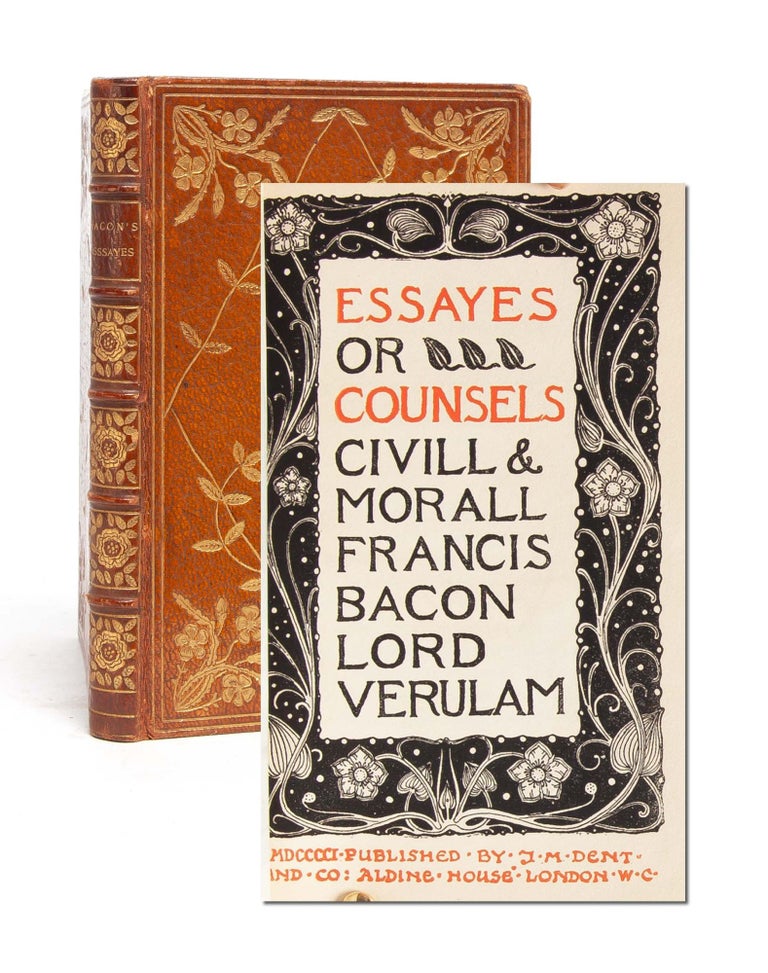[Novum Organum sive indicia vera de interpretatione naturae.] Instauratio Magna.
London: J. Billium, 1620.
![(Item #3330) [Novum Organum sive indicia vera de interpretatione naturae.] Instauratio Magna. Sir Francis Bacon.](https://whitmorerarebooks.cdn.bibliopolis.com/pictures/3330.jpg?auto=webp&v=1586801700)
![(Item #3330) [Novum Organum sive indicia vera de interpretatione naturae.] Instauratio Magna. Sir Francis Bacon.](https://whitmorerarebooks.cdn.bibliopolis.com/pictures/3330.jpg?auto=webp&v=1586801700)
[Novum Organum sive indicia vera de interpretatione naturae.] Instauratio Magna.
London: J. Billium, 1620. First edition. Folio (292 x 192 mm). Original vellum, spine titled in manuscript, ties removed. Housed in a custom green morocco-backed slipcase and chemise. Engraved title page by Simon de Passe. Two leaves with rust-holes touching one or two letters. A very fine, unpressed copy in its original state. With the monogram of George Clarke (1661-1736), the politician and sculptor – and collector – whose library and papers are at Worcester College, Oxford.
As in all but only a very few copies, the text is in the second state, with leaf e3 cancelled, complete with genuine first and last blanks and the medial blank leaf c4.
Bacon’s Novum Organum (a “new instrument” to replace the old Organon of Aristotle) had a revolutionary impact on early modern science by laying the foundation of the inductive method. “Bacon’s insistence on making science experimental and factual, rather than speculative and philosophical, had powerful consequences. He saw clearly the limitations of Aristotelian and scholastic methods and the growing breach between the thinking of his time and that of the Middle Ages is more precisely formulated than in that of, say, Tommaso Campanella or Giordano Bruno. As a philosopher Bacon’s influence on Locke and through him on subsequent English schools of psychology and ethics was profound. Leibniz, Huygens and particularly Robert Boyle were deeply indebted to him, as were the Encyclopédistes, and Voltaire, who called him ‘le père de la philosophie experimentale’” (PMM).
Although the engraved allegorical title - with its evocative engraving of a modern explorer's ship setting confident sail through the Pillars of Hercules, the edge of the world as far as the ancients knew it - gives the title as the “Instauratio Magna”, the book constitutes the planned second part of Part II of the Instauratio (the first part having already appeared as De Augmentis and Book I of The Advancement of Learning). Bacon planned the greater whole in six parts, recalling the six days of the Creation (the plan of the whole work is first printed here), but never completed it. The Novum Organum remains its most influential part. The Philosophical Transactions of the Royal Society were soon to be filled with exactly the kind of “Histories”, careful collections of experimental data, that Bacon here recommends.
Gibson 103; Grolier/Horblit 8b (1st issue); Norman 1:98; Printing and the Mind of Man 119; STC 1163. (Item #3330)

![[Novum Organum sive indicia vera de interpretatione naturae.] Instauratio Magna.](https://whitmorerarebooks.cdn.bibliopolis.com/pictures/3330_2.jpg?width=768&height=1000&fit=bounds&auto=webp&v=1586801700)
![[Novum Organum sive indicia vera de interpretatione naturae.] Instauratio Magna.](https://whitmorerarebooks.cdn.bibliopolis.com/pictures/3330_3.jpg?width=768&height=1000&fit=bounds&auto=webp&v=1586801700)
![[Novum Organum sive indicia vera de interpretatione naturae.] Instauratio Magna.](https://whitmorerarebooks.cdn.bibliopolis.com/pictures/3330_4.jpg?width=768&height=1000&fit=bounds&auto=webp&v=1586801700)
![[Novum Organum sive indicia vera de interpretatione naturae.] Instauratio Magna.](https://whitmorerarebooks.cdn.bibliopolis.com/pictures/3330_5.jpg?width=768&height=1000&fit=bounds&auto=webp&v=1586801700)
![[Novum Organum sive indicia vera de interpretatione naturae.] Instauratio Magna.](https://whitmorerarebooks.cdn.bibliopolis.com/pictures/3330_6.jpg?width=768&height=1000&fit=bounds&auto=webp&v=1586801700)
![[Novum Organum sive indicia vera de interpretatione naturae.] Instauratio Magna.](https://whitmorerarebooks.cdn.bibliopolis.com/pictures/3330_7.jpg?width=768&height=1000&fit=bounds&auto=webp&v=1586801700)
![[Novum Organum sive indicia vera de interpretatione naturae.] Instauratio Magna.](https://whitmorerarebooks.cdn.bibliopolis.com/pictures/3330_8.jpg?width=768&height=1000&fit=bounds&auto=webp&v=1586801700)
![[Novum Organum sive indicia vera de interpretatione naturae.] Instauratio Magna.](https://whitmorerarebooks.cdn.bibliopolis.com/pictures/3330_9.jpg?width=768&height=1000&fit=bounds&auto=webp&v=1586801700)
